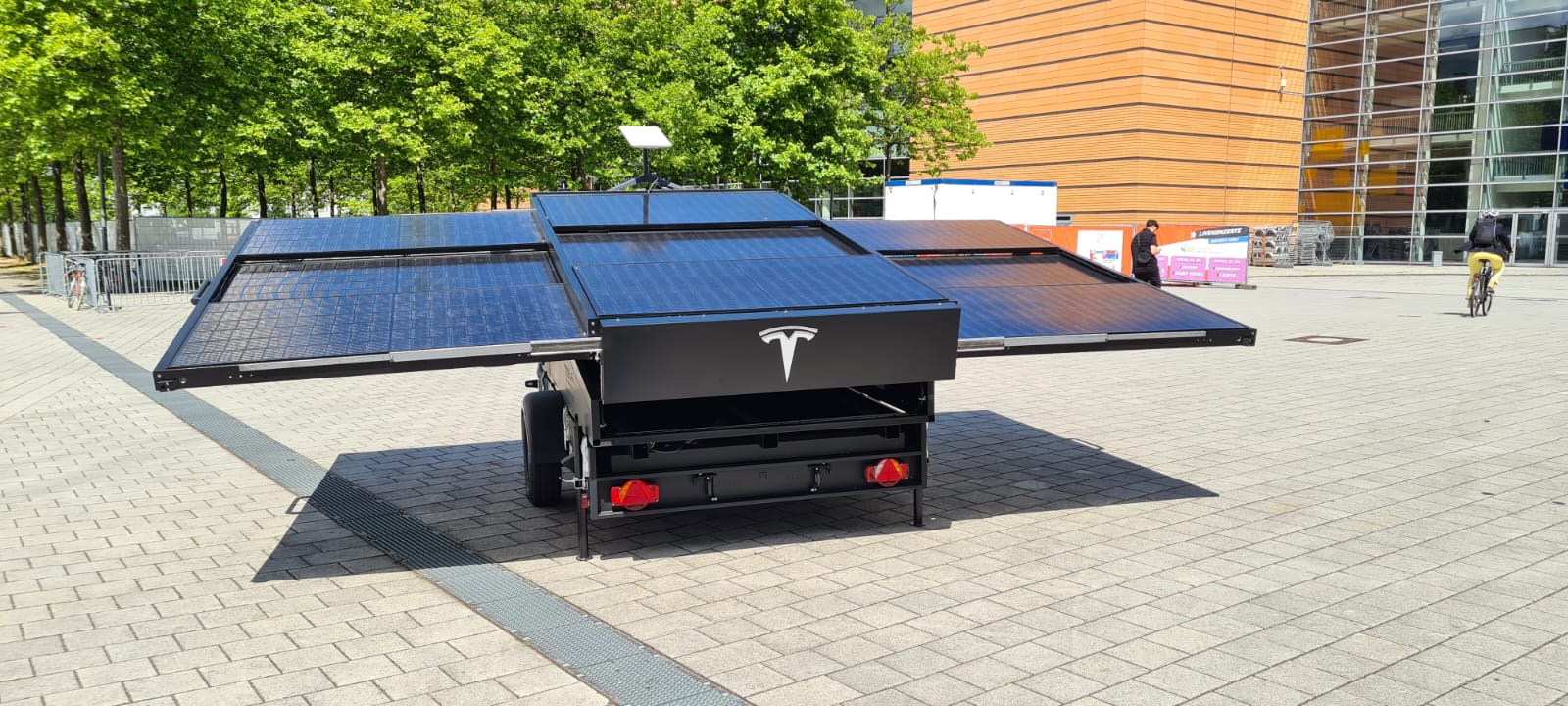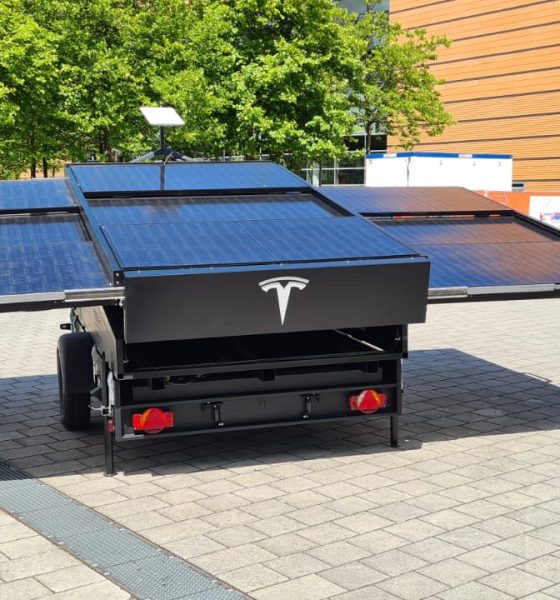

News
Tesla’s Solar Range Extender with Starlink prototype could save lives during disasters
Tesla’s recent prototype of a solar range extender trailer with Starlink will be a game-changer for disaster relief. Tesla Germany recently shared it during the IdeenExpo. Although it is ideally a solution to help customers travel over longer distances, I think it could go further.
When I first saw it, I thought about life-saving solar microgrids deployed during natural disasters. Adding Starlink will keep people connected during disasters. Last year, we had hurricane Ida in my city. We lost power and communications were down. You couldn’t even make a phone call or send a text.
https://twitter.com/tesla_adri/status/1543958596983169025
I recently interviewed Elon Musk last week at Giga Texas and we spoke about how Starlink itself helps with disasters. One of the major differences between Starlink and other internet providers is that it’s not dependent on any ground-based infrastructure. You can bring your dish inside if there’s an upcoming hurricane or disaster. Or bring it with you if you have to evacuate.
Solar, Starlink & Disasters
The solar array extender trailer would keep Starlink online and people connected. And it would save lives for those in disaster areas. Tesla could design them into solar microgrids. This would keep fans and medical devices powered. Regarding Starlink, Elon Musk told me:
“Well, just in general, Starlink, because it is not dependent on any ground-based infrastructure can provide internet connectivity to areas that have had floods or fires or earthquakes that t have destroyed the ground-based infrastructure.”
“That’s obviously extremely helpful for rescuing people and people being able to ‘I need to I need help. I need rescue.’ It’s like how do you find them? How do you communicate with them? Starlink can and has provided that in a number of situations.”
Another Idea For Starlink & Communications
I shared another idea with Elon Musk. The Zello app helped many in my area stay in contact during Ida’s aftermath. Being unable to make a call or text left me feeling isolated from the rest of the world. It only worked for short-range though. My friends were able to send me messages but it took a while for the to come through. Using Starlink to create a WiFi bridge that extends the range of the app would be helpful.
Climate Change Will Force Millions From Their Homes In The Next 30 Years.
Climate change could force over 200 million people from their homes within the next three decades. It’s already happening in Louisiana. Residents of Isle de Jean Charles have experienced this firsthand. During Ida, Grande Isle was completely wiped out and it took months just to clear up the debris. This is just my little corner of the world.
I hope that Tesla produces the solar range extender trailer with Starlink. And I hope they design it into a microgrid with internet. It will save lives.

News
Tesla China quietly posts Robotaxi-related job listing
Tesla China is currently seeking a Low Voltage Electrical Engineer to work on circuit board design for the company’s autonomous vehicles.

Tesla has posted a new job listing in Shanghai explicitly tied to its Robotaxi program, fueling speculation that the company is preparing to launch its dedicated autonomous ride-hailing service in China.
As noted in the listing, Tesla China is currently seeking a Low Voltage Electrical Engineer to work on circuit board design for the company’s autonomous vehicles.
Robotaxi-specific role
The listing, which was shared on social media platform X by industry watcher @tslaming, suggested that Tesla China is looking to fill the role urgently. The job listing itself specifically mentions that the person hired for the role will be working on the Low Voltage Hardware team, which would design the circuit boards that would serve as the nervous system of the Robotaxi.
Key tasks for the role, as indicated in the job listing, include collaboration with PCB layout, firmware, mechanical, program management, and validation teams, among other responsibilities. The role is based in Shanghai.
China Robotaxi launch
China represents a massive potential market for robotaxis, with its dense urban centers and supportive policies in select cities. Tesla has limited permission to roll out FSD in the country, though despite this, its vehicles have been hailed as among the best in the market when it comes to autonomous features. So far, at least, it appears that China supports Tesla’s FSD and Robotaxi rollout.
This was hinted at in November, when Tesla brought the Cybercab to the 8th China International Import Expo (CIIE) in Shanghai, marking the first time that the autonomous two-seater was brought to the Asia-Pacific region. The vehicle, despite not having a release date in China, received a significant amount of interest among the event’s attendees.
Elon Musk
Elon Musk and Tesla AI Director share insights after empty driver seat Robotaxi rides
The executives’ unoccupied tests hint at the rapid progress of Tesla’s unsupervised Robotaxi efforts.

Tesla CEO Elon Musk and AI Director Ashok Elluswamy celebrated Christmas Eve by sharing personal experiences with Robotaxi vehicles that had no safety monitor or occupant in the driver’s seat. Musk described the system’s “perfect driving” around Austin, while Elluswamy posted video from the back seat, calling it “an amazing experience.”
The executives’ unoccupied tests hint at the rapid progress of Tesla’s unsupervised Robotaxi efforts.
Elon and Ashok’s firsthand Robotaxi insights
Prior to Musk and the Tesla AI Director’s posts, sightings of unmanned Teslas navigating public roads were widely shared on social media. One such vehicle was spotted in Austin, Texas, which Elon Musk acknowleged by stating that “Testing is underway with no occupants in the car.”
Based on his Christmas Eve post, Musk seemed to have tested an unmanned Tesla himself. “A Tesla with no safety monitor in the car and me sitting in the passenger seat took me all around Austin on Sunday with perfect driving,” Musk wrote in his post.
Elluswamy responded with a 2-minute video showing himself in the rear of an unmanned Tesla. The video featured the vehicle’s empty front seats, as well as its smooth handling through real-world traffic. He captioned his video with the words, “It’s an amazing experience!”
Towards Unsupervised operations
During an xAI Hackathon earlier this month, Elon Musk mentioned that Tesla owed be removing Safety Monitors from its Robotaxis in Austin in just three weeks. “Unsupervised is pretty much solved at this point. So there will be Tesla Robotaxis operating in Austin with no one in them. Not even anyone in the passenger seat in about three weeks,” he said. Musk echoed similar estimates at the 2025 Annual Shareholder Meeting and the Q3 2025 earnings call.
Considering the insights that were posted Musk and Elluswamy, it does appear that Tesla is working hard towards operating its Robotaxis with no safety monitors. This is quite impressive considering that the service was launched just earlier this year.
Elon Musk
Starlink passes 9 million active customers just weeks after hitting 8 million
The milestone highlights the accelerating growth of Starlink, which has now been adding over 20,000 new users per day.

SpaceX’s Starlink satellite internet service has continued its rapid global expansion, surpassing 9 million active customers just weeks after crossing the 8 million mark.
The milestone highlights the accelerating growth of Starlink, which has now been adding over 20,000 new users per day.
9 million customers
In a post on X, SpaceX stated that Starlink now serves over 9 million active users across 155 countries, territories, and markets. The company reached 8 million customers in early November, meaning it added roughly 1 million subscribers in under seven weeks, or about 21,275 new users on average per day.
“Starlink is connecting more than 9M active customers with high-speed internet across 155 countries, territories, and many other markets,” Starlink wrote in a post on its official X account. SpaceX President Gwynne Shotwell also celebrated the milestone on X. “A huge thank you to all of our customers and congrats to the Starlink team for such an incredible product,” she wrote.
That growth rate reflects both rising demand for broadband in underserved regions and Starlink’s expanding satellite constellation, which now includes more than 9,000 low-Earth-orbit satellites designed to deliver high-speed, low-latency internet worldwide.
Starlink’s momentum
Starlink’s momentum has been building up. SpaceX reported 4.6 million Starlink customers in December 2024, followed by 7 million by August 2025, and 8 million customers in November. Independent data also suggests Starlink usage is rising sharply, with Cloudflare reporting that global web traffic from Starlink users more than doubled in 2025, as noted in an Insider report.
Starlink’s momentum is increasingly tied to SpaceX’s broader financial outlook. Elon Musk has said the satellite network is “by far” the company’s largest revenue driver, and reports suggest SpaceX may be positioning itself for an initial public offering as soon as next year, with valuations estimated as high as $1.5 trillion. Musk has also suggested in the past that Starlink could have its own IPO in the future.








